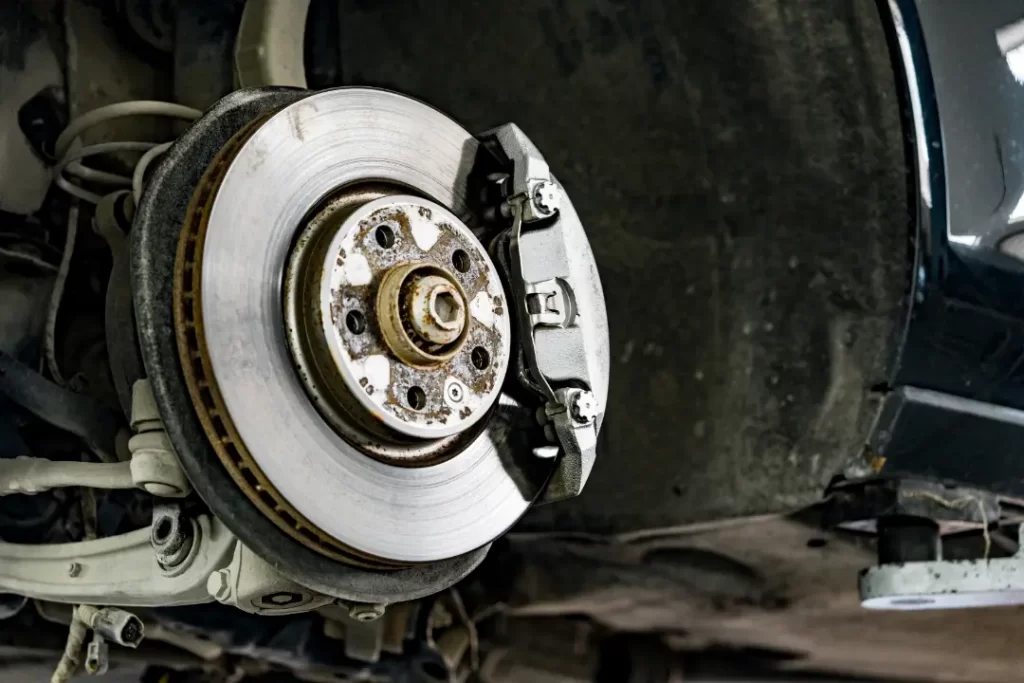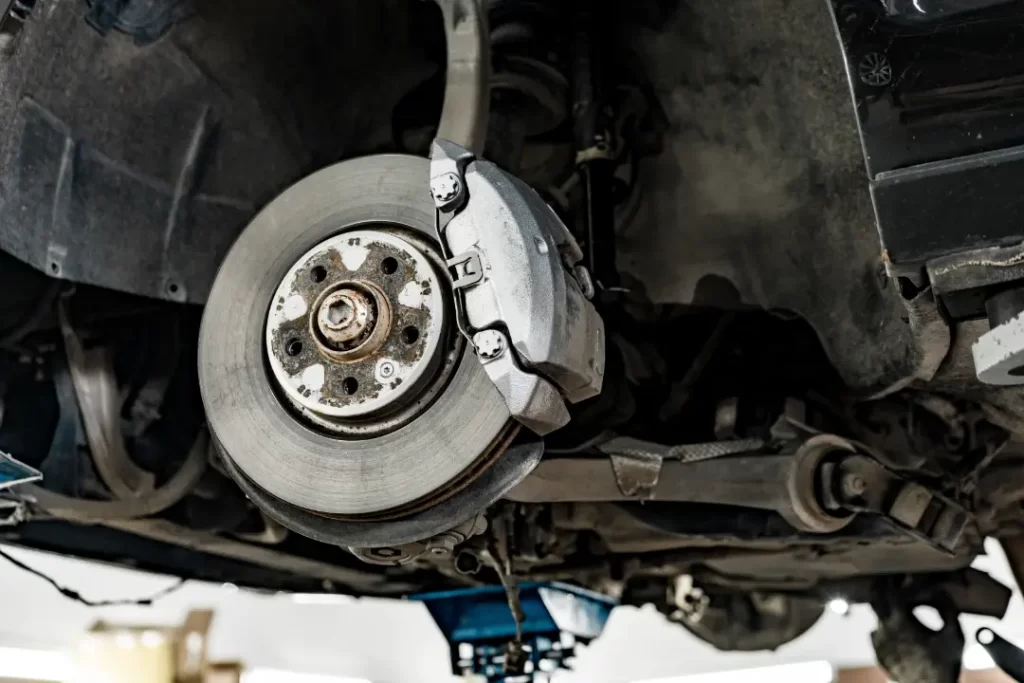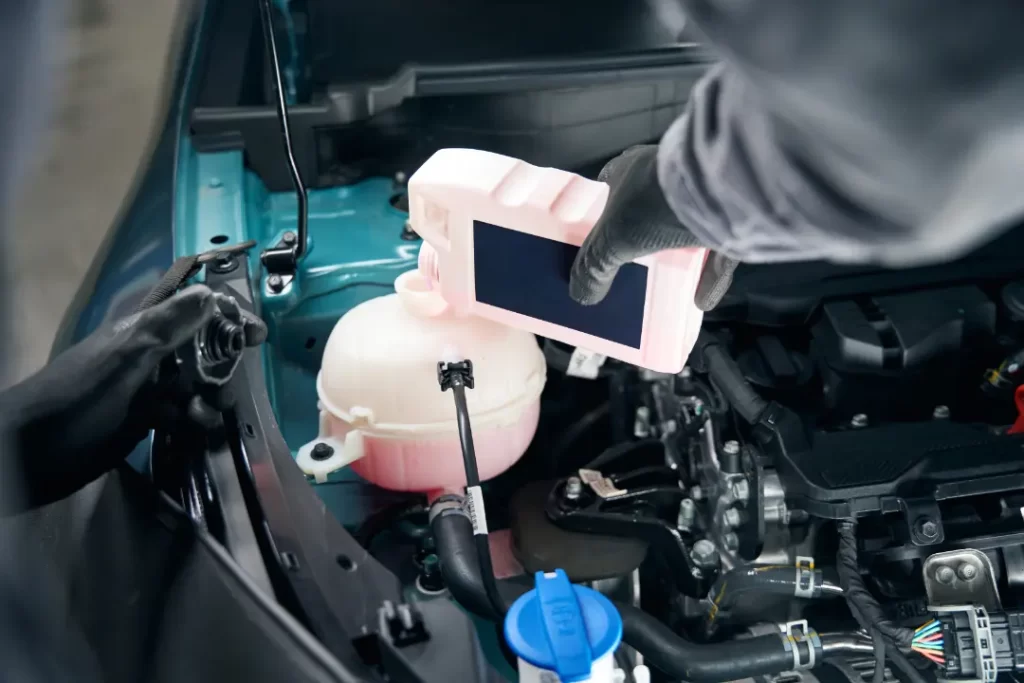Ensuring your car’s brakes are functioning correctly is crucial for safety. This guide will teach you how to check the brakes on cars efficiently, including visual inspections and recognizing warning signs. Let’s dive in.
Key Takeaways
- Understanding the components and functions of the braking system, including brake pads, discs, callipers, and brake fluid, is essential for effective maintenance.
- Regular inspections of brake pads and discs are crucial; visual checks can be done without removing wheels, while detailed assessments require wheel removal to identify wear and the potential need for replacement. Removing the wheels allows for a comprehensive view of the brake system, including the brake pads, calliper, rotor, and brake lines, which should be carefully examined for any signs of wear or damage.
- Warning signs such as unusual noises, vibrations during braking, and a car pulling to one side should prompt immediate inspection and possible professional servicing to maintain safety and braking efficiency.
The Mechanics of Your Car’s Braking System
The braking system in your car is a complex network of components that work together to ensure that your vehicle stops safely. At the core of this system are the brake pads, crucial for creating the friction needed to stop the car when you press the brake pedal. These pads, along with other components like discs and callipers, are part of a system that usually includes both disc and drum brakes, with modern vehicles often featuring advanced anti-lock braking systems (ABS).
Brake fluid plays a crucial role in the braking process. When you press the brake pedal, the fluid transmits the force to the braking components, ensuring that the brakes engage effectively. This hydraulic pressure activates the brakes, allowing your vehicle to come to a smooth stop. Understanding the role of brake fluid in this process is not just informative, it’s essential for maintaining your vehicle’s safety and reliability.
Key components of the braking system include the brake pads, discs, callipers, and fluid. These parts must work together to provide optimal braking performance. Understanding how these components interact can help you better diagnose issues and maintain your brake system effectively.

What are Brake Pads and How Do They Work?
Brake pads are a crucial component of your car’s braking system, playing a vital role in ensuring your vehicle’s safety and reliability. These flat pieces of steel, with friction material on one side, are designed to contact the brake discs when you press the brake pedal. This contact creates the necessary friction to slow down the wheels’ rotation, ultimately bringing your vehicle to a stop.
Understanding the different types of brake pads and their characteristics can help you make informed decisions about your vehicle’s maintenance. Non-metallic or organic brake pads are the softest type, wearing out quickly and producing large amounts of brake dust. Semi-metallic brake pads are the most common, offering a balance between heat resistance and braking performance. Ceramic brake pads, while the most expensive, provide excellent heat resistance and produce less brake dust.
By understanding these differences, you can choose the right brake pads for your vehicle and driving style, empowering you to make confident decisions about your car’s maintenance.
How to Inspect Brake Pads
Regularly inspecting your brake pads is not just a good practice, it’s an essential part of car maintenance. Thin and worn brake pads can significantly reduce stopping power, which can be dangerous. By taking the initiative to notice any changes in your car’s braking performance and checking the brake pads, you are actively contributing to your vehicle’s safety and reliability. Additionally, having the brakes checked if you notice warning signs like unusual noises or vibrations is critical for vehicle safety and maintenance.
Factors such as driving style, road conditions, and vehicle weight can significantly affect how quickly your brake pads wear out. By understanding these factors, you can better anticipate when your brake pads might need replacement, making you a more informed and knowledgeable car owner.
There are two primary methods to inspect your brake pads: a visual inspection without removing the wheels and a more detailed inspection that requires you to remove the wheels.
Visual Inspection Without Removing Wheels
One of the quickest ways to check your brake pads is to visually inspect them without removing the wheels. Using a flashlight, look through the holes in the wheels to assess the thickness of the brake pads. When less than 3mm of the pad is visible, it’s time for an immediate inspection and possible replacement.
Many brake pads feature a wear indicator slot, which helps to signal when the pads need replacement. If the wear indicator tab almost touches the rotor, it’s a clear sign that the brake pads must be replaced. Frequent visual checks can detect worn brake pads early, preventing further damage to the braking system.
Removing Wheels for Detailed Inspection
You must remove the wheels to inspect your car’s brake pads more thoroughly. Start by jacking up the vehicle and removing the lug nuts and tyres. Once the wheel is off, you can carefully inspect the brake pads for excessive wear.
Brake pads should be replaced when they are less than 1/4 inch thick or have a minimum thickness of 4 millimetres. Regular detailed inspections ensure that your brake pads remain in good condition and offer reliable braking performance.
Checking Brake Discs
Brake discs, also known as rotors, are another crucial braking system component. Their surface should be shiny, with only minor surface lines. Significant grooves or a reduced shine indicate that the disc needs to be replaced.
Front brake pads are essential for vehicle safety. They generally wear out faster than rear pads, requiring more frequent replacement. Worn front brake pads can cause vehicle drift and other safety issues.
Visible grooves or imperfections on brake discs can compromise their performance, increasing stopping distances. A smooth and even surface on brake discs ensures better friction and braking efficiency. Frequent brake disc inspections maintain optimal braking performance and safety.
Brake Pad Thickness and Replacement
Monitoring your brake pads’ thickness is essential for optimal braking performance and safety. Generally, brake pads should be replaced when they reach a 1/4 inch (6.4 mm) or less thickness. Some experts recommend replacing them, around 1/8 inch (3.2 mm) or 1/3 inch (8.5 mm), depending on your vehicle and driving conditions.
To check your brake pads regularly, use a vernier calliper or a simple drinking straw to measure their thickness. If you’re unsure how to check brake pads or interpret the results, consult your vehicle’s owner’s manual or seek the advice of a professional mechanic. Regular checks ensure that your brake pads remain within the recommended thickness, providing reliable braking performance.
When to Replace Brake Pads
Knowing when to replace your brake pads is crucial for maintaining your vehicle’s safety. Here are some common indicators that your brake pads may need replacement:
- Squealing or grinding noises when braking
- Vibrations or pulsations in the brake pedal
- Longer stopping distances
- Deeper brake pedal press
- Braking causes vehicle drift.
- Pads reach minimum thickness.
If you notice these symptoms, your brake pads must be inspected and replaced immediately. Driving with worn-out brake pads can lead to serious consequences, including accidents and injuries. Timely replacement ensures that your braking system functions effectively, keeping you and others on the road safe.
Warning Signs of Brake Issues
Awareness of the warning signs that your brakes may need attention can help prevent serious issues. Dashboard warning lights, unusual noises, and vibrations are common indicators. If your brake pads have less than 1/4 inch of friction material, it’s time for a replacement.
Visible grooves and a loss of shine on the surface are signs that your brake discs need replacing. Noticing any of these symptoms warrants a brake check and possible replacement by a technician.
We’ll delve deeper into these warning signs in the following subsections.

Unusual Noises
Unusual noises are often the first sign that something is wrong with your brakes. Common noises that indicate worn brake pads include grinding, growling, or squealing. A loud metallic squealing sound upon braking typically signifies that the brake pads are worn and need replacement.
Grinding noises typically indicate completely worn-down brake pads needing urgent attention. Rust buildup on brakes can also cause a squealing noise, suggesting the need for maintenance.
Regularly listening for these sounds can help you address brake issues before they become severe.
Vibrations When Braking
Experiencing brake pedal or steering wheel vibrations when braking often suggests that the rotors are warped. Warped brake discs can create high spots, causing bumpy contact with the brake pads and leading to vibrations.
Ignoring these vibrations can lead to decreased braking efficiency and potential damage to the braking system. Experiencing vibrations when braking necessitates checking and possibly replacing the rotors for safe and effective braking.
Car Pulling to One Side
A car pulling to one side during braking is usually due to uneven braking force across the wheels. Causes of uneven braking include sticking callipers, uneven brake pad wear, or varying brake fluid pressure. Sticking callipers can cause one side of the braking system to engage more than the other, leading to a pull to one side. It is also important to monitor the wear and condition of rear brake pads to ensure even braking force and prevent the car from pulling to one side.
A car pulled to one side requires a professional inspection to identify and resolve the issue.
Stay Safe on the Road with Ivydene Garage’s Professional Brake Care—Over 40 Years of Experience
At Ivydene Garage in Ashford, we’re more than just mechanics—we’re your dedicated partners in ensuring your vehicle’s safety. Specialising in brake repairs and replacements, we utilise the latest technology and the highest quality parts to guarantee your car stops as it should. Whether it’s a routine check or a complete brake system overhaul, our experienced team handles every make and model with precision and care. With us, you’re not just getting a service; you’re investing in peace of mind and road safety.
Why settle for less when your safety is on the line? At Ivydene Garage, we stand by our work with guarantees that ensure you drive away confidence in your brakes’ performance. Our competitive pricing, coupled with our expertise, makes us the top choice for brake services in Ashford.
Don’t wait for a problem to arise—schedule your brake inspection or replacement with us today, and prevent potential issues before they become serious.
Importance of Monitoring Brake Fluid
Brake fluid plays a vital role in ensuring the proper functioning of your braking system. It should be clear or slightly yellow. If the brake fluid is very dark, it indicates that it needs to be replaced. Maintaining proper brake fluid levels is crucial in preventing brake failure and ensuring safe vehicle operation.
Replacing dark brake fluid is essential to maintain effective braking performance and prevent potential brake failure. Regular checks and maintenance of brake fluid are necessary to ensure that your braking system works reliably.

Cost and Process of Replacing Brake Pads
The cost of replacing brake pads can vary depending on your vehicle’s make and model and the type of brake pads used. The average cost ranges from £90 to £165 for two wheels. However, this may not include additional repairs or maintenance, such as replacing the brake rotors or fluid.
The process of replacing brake pads typically involves the following steps:
- Jack up the vehicle and remove the wheel.
- Inspect the brake pads and rotors for wear or damage.
- Remove the old brake pads and clean the brake calliper.
- Install new brake pads and reassemble the brake calliper.
- Bleed the brake system to remove any air or debris.
- Test the brakes to ensure proper function and safety.
While some car owners may choose to replace brake pads themselves, having a professional mechanic perform the replacement is recommended, especially if you’re unfamiliar with brake systems or don’t have the necessary tools and expertise. This ensures that the job is done correctly and safely, providing peace of mind and reliable braking performance.
Tips to Extend Brake Life
Mindful driving habits can significantly extend the lifespan of brake components. Driving at moderate speeds reduces the force required for braking, which helps prolong brake pad life. Using engine braking while going downhill minimizes reliance on brake pads, extending their lifespan.
Defensive driving allows for early braking, resulting in smoother stops that are less taxing on brake components. Removing unnecessary weight from the vehicle reduces the strain on brakes, aiding in the longevity of brake pads. These habits can help you get the most out of your brake system.
Frequently Asked Questions
How often should I check my brake pads?
You should check your brake pads every 12,000 miles or annually to ensure optimal performance and safety. Regular inspections can help prevent costly repairs and maintain vehicle safety.
What are the signs that my brake discs need replacing?
If you notice visible grooves or a loss of shine on your brake discs, it clearly indicates that they need replacement. Timely intervention can ensure your vehicle’s safety and performance.
Why is my car pulling to one side when braking?
The car pulling to one side when braking is typically caused by uneven braking force, often resulting from sticking callipers or uneven brake pad wear. Addressing these issues promptly is crucial for maintaining safe vehicle operation.
How can I extend the life of my brake pads?
To extend the life of your brake pads, practise mindful driving by maintaining moderate speeds and employing defensive driving techniques. This approach will help reduce unnecessary wear and prolong their effectiveness.
Why is professional brake inspection important?
Professional brake inspection is crucial as it can identify wear and potential issues early, thereby preventing brake failure and ensuring the safety of your vehicle. Regular inspections are an essential part of vehicle maintenance.
Conclusion
Regular brake maintenance is crucial for safety and performance. You can ensure your vehicle stops safely and effectively by understanding your braking system, inspecting brake pads and discs, recognizing warning signs, monitoring brake fluid, and seeking professional brake checks. Remember, keeping your brakes in top condition protects you and everyone else on the road. For expert brake services that you can trust, visit Ivydene Garage in Ashford—where your safety is our top priority.
